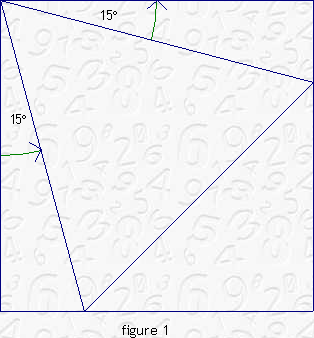- Given a general convex region C, to find the largest regular polygon that is contained in it (shared boundaries allowed). Basically, one needs to find that particular value of n for which a regular n-gon contained in C has the largest area.
Example: If C is an isosceles right triangle of area 1 unit, the largest square (n=4) contained in it has area 1/2 unit and this appears more than the area of the largest equilateral triangle (n=3) or largest circle (n -> infinity) that is contained in C.
A related question: Given a value of n, can one find some triangle such that the largest regular polygon inscribed in the triangle has exactly n sides? One guess is that n cannot be arbitrarily large if C is restricted to be some triangle - iow, that for any triangle, the largest contained regular n-gon cannot be the incircle.
Another related question: Given a convex region C and a positive integer n>=3. Let A(n) be the area of the largest n-gon that can be drawn inside C. What could one say in general about the behavior of A(n) as n increases? For example, does A(n) have exactly one local maximum (which is also the global max) for any C?
Further remark: We can think of a classification of all convex regions (including non-polygonal ones) into a countable number of categories based on which regular n-gon, when inscribed in the convex region, gives max area.
Regarding question 2, above, here is a guess: (Qn: Given a value of n, can one find some triangle such that the largest regular polygon inscribed in the triangle has exactly n sides?) Take an isosceles obtuse triangle with largest angle = 180 - 360/n. For it, the largest inscribed regular polygon will have n sides. Eg: for any obtuse triangle with largest angle 108, the largest inscribed regular n-gon is the regular pentagon.
Note: This guess looks likelier to be valid for odd n. But it does not seem useful for large n. Indeed, if we plug in a large value of n into 180 - 360/n, ie. considering isosceles triangles with large obtuse angle, the square (n=4) would be a larger inscribed regular polygon than a regular n-gon.


